
10 minute read
KidsontheBlock


Advertisement


ByStaceyBartlett

IsaacSiegel-HanlyisturningtenonJanuary 22nd.
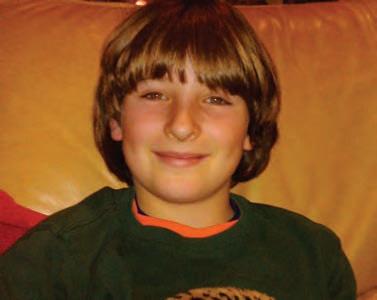
Zach and Isla Update: This month our school studied the ocean. We’re so lucky to see marine life every day. We see and play with orange and red starfsh; our dad sees dolphinseverydayonhiswaytowork,andfor the past week we’ve seen seven eagle rays fying in formation right off our dock. Our favorite marine animal is the moon jellyfsh. They don’t sting, and you can scoop them right out of the water with your hands. They feel like slimy rubber; my mom says they feel like you’re holding sunny-side-up eggs. PotreroHillresidentsZachandIsla,andtheir parents, are spending a year in Panama and are contributing monthly insights on their adventures.
MississippiStreetresidentsBeckyandJasonBarton welcomedConnorRichardBartontotheworldon October 2nd. Connor, a second generation San Franciscan,isenjoyinghismanywalksaroundthe neighborhood.DadisespeciallyhappyConnorhas taken to their weekly routine of visiting Thinkers Caféforabreakfastburrito.
week. The hospital is also the City’s largest inpatient and rehabilitation hospital for psychiatric patients. With an operating budget of $465 million, SFGH employs 2,000 UCSF doctors and nurses, and 3,500 City employees, who provide services in more than 20 languages to 100,000 patients annually, regardless of their ability to pay.
Although SFGH’s plans don’t include construction of a helipad, state Assembly Bill 1272 would require the hospital to build such a facility to accommodate air transport of trauma patients. The bill, which is ercely opposed by a number of Potrero Hill residents, is currently awaiting action in the Senate Health Committee.
Pier 70 Waits for the Development TidetoComein
Pier 70, a 65-acre bay front site east of Illinois Street between Mariposa and 22nd streets, houses the most important collection of historic industrial buildings west of the Mississippi. The site has been identi ed as a future National Historic District for its 150 years of shipbuilding and the architectural treasures left behind. Efforts are underway to redevelop the pier as a unique waterfront museum attraction. Roughly $650 million is needed to make the salvageable buildings safe, demolish the unsalvageable ones, clean up lingering toxins, improve the streets and utility infrastructure, create a waterfront park, and reconstruct sidewalks and outdoor lighting.
The pier houses 40 dilapidated, seismically unfit buildings, some with un-reinforced masonry, most of which are deteriorating rapidly, with leaking and broken windows. A significant earthquake could topple one or more of the structures. Under port guidelines, at least 17 of the most historically signi cant buildings need to be retained and retrofitted. The pier is classified as a Brownfield site, and could be contaminated with volatile petroleum hydrocarbons, PCBs, asbestos, methane and sul de gas, and dioxin. Environmental consultants Treadwell and Rollo will complete a soil and groundwater assessment this year, and make recommendations on site remediation.
The 10-member Central Waterfront – formally known as the Pier 70 – Advisory Group has been meeting for more than a decade to plan for the pier’s redevelopment. The group hopes to nalize a master plan by this spring. The plan would allow for three million square feet of new buildings, 700,000 square feet of adaptive historic reuse, the rehabilitation of the 100,000-squarefoot historic Union Iron Works Machine shop for cultural or civic use, preservation of existing dry dock services, and eleven acres of open space along the waterfront plus nine acres throughout the site.
The trick is “how to attract developers without scaring them away by all the challenges,” said port planner Mark Paez. “We know these buildings won’t be around much longer if we don’t stabilize them right now. The more we do, the better kind of deal we can strike with developers because if they think it’s a risky project, then they charge more. We’re setting up a framework everybody can agree on when the project goes forward. What we don’t want is a developer to sit on a property. That would be the worst case. We don’t want it to take forever, waiting for the market to turn around or to go as slow as possible.”
The port is patching together a mix of financing mechanisms to support the project, including an expected $45 million in lease revenue from Seawall Lot 337, which is located just south of AT&T Park, and $205 million in Infrastructure Finance Bond funds and tax increment funding. The State Historic Preservation Office has determined that Pier’s 70 historic features make it eligible for listing on the National Register of Historic Places, qualifying it to receive roughly $45 million in federal tax credits.
Two development teams have submitted proposals to remake the 16-acre Seawall Lot 337, currently a large parking lot. The San Francisco Giants together with Farallon Capital Management would spend $1 billion on 875 units tucked into a 300-foot building, 800,000 square feet of office space, parking, a 5,000 seat music hall, a bowling alley, nightclubs, and a ve-acre park. The developers are working with Darius Anderson, owner of Kenwood Investments, with plans to create a Ferry Building-style farmer’s market and restaurants, and offer below-market rents on gallery space.
Pier 70 was one of country’s most productive World War II shipyards. In its heyday it employed 10,000 workers in three daily shifts, producing 72 vessels, 52 for combat, and repairing 2,500 navy crafts. A destroyer could be built in less than a month. In 1967 the pier’s yards constructed 57 300-foot-long, 800-ton steel tubes for the Bay Area Rapid Transit’s bay tunnel. Today, BAE Systems employs roughly 175 union ship repair workers, maintaining one the West Coast’s largest cruise ship drydock repair facilities. Autoreturn, the City’s towing service, is located at the end of 22nd Street. Sims Metal, Delancey Street Foundation’s storage space is also located at the pier, as is since 1997, radio station KEST 1450 AM, which has a 180-foot antenna tower at the end 20th Street.
The Third Street Entry Place at the University of California, San Francisco Mission Bay campus was one of the design elementssuggested by neighborhood activists during the project’s design process.
UCSF Mission Bay Creates BiotechnologyCente r

The 303-acre mixed use, transitoriented Mission Bay development is a partnership between UCSF, the San Francisco Redevelopment Agency, and Mission Bay Development Corporation. The project is bordered by the bay, AT&T Park, Mariposa, and Seventh streets. It includes the 43acre UCSF life science campus with lab space, three research buildings, a community center, and student housing.
When Mission Bay is fully built out, it will include six thousand housing units, 1,700 of which will be affordable. To date 3,126 homes have been constructed, including 674 below market units, with an additional 319 units under construction. Eleven acres of new parks have been completed, with 41 acres of open space in total planned along Mission Creek and the bay, as well as eight acres of open space within the UCSF campus. The 4.5 acre Mission Creek
Sports Park at 401 Berry Street features a boat launch, gravel dog run, and volleyball and basketball courts. Fourth Street is slated to serve as Mission Bay’s central shopping street, consisting of ground oor retail tailored to pedestrians and cyclists. Café Terzetto, Peasant Pies, and Subway Sandwiches have opened along the strip.
QB3, the California Institute of Quantitative Biosciences, is collaborating with FibroGen, the biotechnology drug discovery company to launch the 2,500 square foot QB3 Mission Bay Incubator Network, or “QB3 Garage,” which will foster startup companies and entrepreneurs with access to laboratory space, mentors, networking, and the UCSF library system. Nektar Therapeutics, which has nine products in development, has leased 100,000 square feet of office space in the west wing of a building across the street from the Mission Bay campus.
Several public infrastructure projects are being considered for the area. The Dogpatch Neighborhood Association has been advocating that the Bluepeter Building, located near Bay Front Park’s southern edge at 555 Illinois Street at Terry Francoise Boulevard, be preserved. The twostory wooden building with a vaulted roof, which was built around 1940, could be used for a community meeting space, child care center or food vending. The structure, which is ineligible for the Historic Places National Register, was once owned by a ship chandlery business, and
ContinuedonPage26
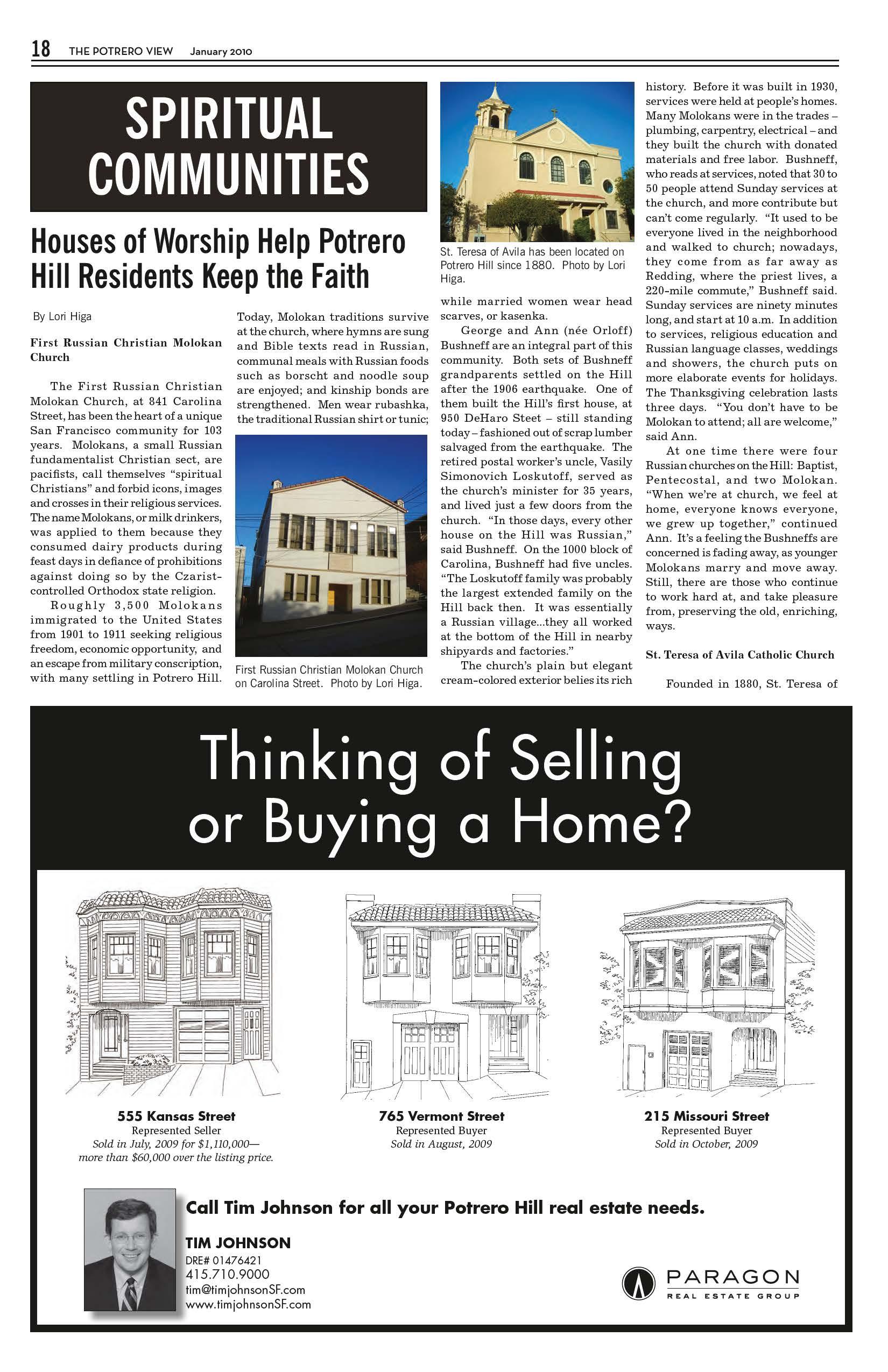
Avila Church, the beautiful pink church located at the top of 20th – also known as Peter Sammon Way – and Connecticut streets is an iconic symbol of the Hill. The comfy rectory is led by Father Paul Warren, a third-generation native San Franciscan, who was born at St. Joseph’s hospital and raised in the Avenues. Warren, who has been with St. Teresa’s for ve years, is responsible for the small, 130-yearold parish. He came to the church during a time of transition, after the passing of Father Peter Sammon, who had helmed the roughly 350-member parish for 40 years. “For many years, St. Teresa was identi ed exclusively with Potrero Hill,” Warren said. The original church, built at the turn of the century, was at 19th and Tennessee streets. When the 280 freeway was built, the church was cut in half and moved to its current location. The church’s original school, which was torn down and replaced by a new one on Connecticut, was shuttered in 1974, and is now leased to the American College of Traditional Chinese Medicine.
St. Teresa’s is known for its community service. Working with the St. Vincent de Paul Society, the church helps needy families in a variety of ways. Every Thanksgiving, the church distributes food baskets with turkeys to 125 families, including Daniel Webster Elementary School children. The church provides food weekly, as well as furniture and clothing, to the needy. And parishioners make home, hospital and elder care visits. This year, 4,137 people received help from St. Teresa’s, and the church raised $13,000. The funds were directed to such places as the Rosalie House Emergency Shelter, Martin De Porres House of Hospitality, and the convalescent home on Pennsylvania Street, “that used to be the old Kaiser hospital,” Warren said.
Services are held on Saturdays at 4:15 p.m.; Sundays at 8:30 and 10 a.m.. Masses are held Tuesdays and Fridays at 8:30 a.m., except for First Friday, on which a special Mass for seniors is held at 11 a.m., followed by luncheon. The church recently hired musical director Janelle O’Malley, who is also the liturgist and leads liturgy groups. There’s live music and singing at services, with coffee and donuts after the 10 a.m. service. First Sunday of the month is “Welcome Sunday” for new members. Sister Maureen O’Brien, former principal of St. Paul’s Catholic High School, where the Whoopi Goldberg movie Sister Act was lmed, serves as pastoral associate and guides the St. Vincent de Paul and youth religious education programs. According to Warren, the church’s biggest challenge is to broaden its membership, especially to new residents, including those at the University of California, San Francisco Mission Bay campus and in the new developments that have sprung up.

St. Teresa’s recently held what Warren hopes will become an annual tradition: its rst-ever Christmas dinner, with entertainment provided by neighbors Goat Hall and its Starlight Choristers across the street. “We love engaging with our neighbors...It’s a struggle to grow the parish, especially with the increasing costs of housing in the City, ights to suburbia, and the transitory urban population,” Warren said.

St. Gregory’s of Nyssa Episopal Church
Sitting inside a homey office, filled with books and iconic art, Rector Paul Fromberg, originally from Houston, has led St. Gregory’s congregation for the past year. The church was founded in 1978 by two Episcopal priests, Rick Fabian and Don Schell, the latter of whom still lives on Rhode Island Street. They initially rented space at Trinity Episcopal on Bush and Gough. With the approval of the diocese, they built their own church at De Haro and Mariposa streets in 1994, which today is distinguished by its magni cent Dancing Saints icons.
The larger-than-life-sized paintings by artist Mark Dukes, completed a year ago after 12 years of work, encompass 90 gures, each representing someone chosen by the congregation who exemplifies living in friendship with God. “They’re from all religions, eras and backgrounds, from Cesar Chavez to Queen Elizabeth I, and represent the congregation, which dances as we sing around the table at service,” explained Fromberg. “It’s one way to show that to which we aspire, manifested in the lives of people who dance in heaven. It’s a great teaching piece.” He regularly gives talks on the Dancing Icons to students, including those attending nearby Live Oak School. The church also offers classes in icon painting two Sundays a month.
The church’s patron saint was a fourth century, classically trained philosopher-humanist-mystic from central Turkey who believed “God’s love is universal and inclusive.”
St. Gregory was the first liberal bishop before “the clampdown,” said Fromberg, “who believed that the one thing truly worthwhile is becoming God’s friend. He was ahead of his time. It is in that spirit that we do our work.” With roughly 350 members from all over the Bay Area, St. Gregory’s “exists for the community,” Fromberg emphasized. This commitment is obvious; one merely has to look at the astounding quantity of programs and services St. Gregory’s offers, the idea for each inspired by members who bring their passion and ideas to the church, where they then come to fruition. “Our members tell us what is important, so we know to do work that is valued,” Fromberg said.
Nine years ago, the church started a food pantry, at which, every Friday 1,000 clients come to the farmers market held inside the sanctuary and choose whatever foods they want. The pantry has since become a separate nonpro t, and has spun-off 14 other locations in San Francisco, including at Starr King Elementary School and International Studies Academy, where student volunteers run food giveaways. Financial donations come from all over the City and the country, as well as from St. Gregory’s members. The church also works with the interfaith Sojourn Chaplaincy at San Francisco General Hospital, and Girls Hope Boys Hope, a program offering educational support and residencies for youth without resources. “We’re happy to be a gathering place for, and to engage with the neighborhood... we’re a polling location, hold census worker training and book groups
ContinuedonPage20
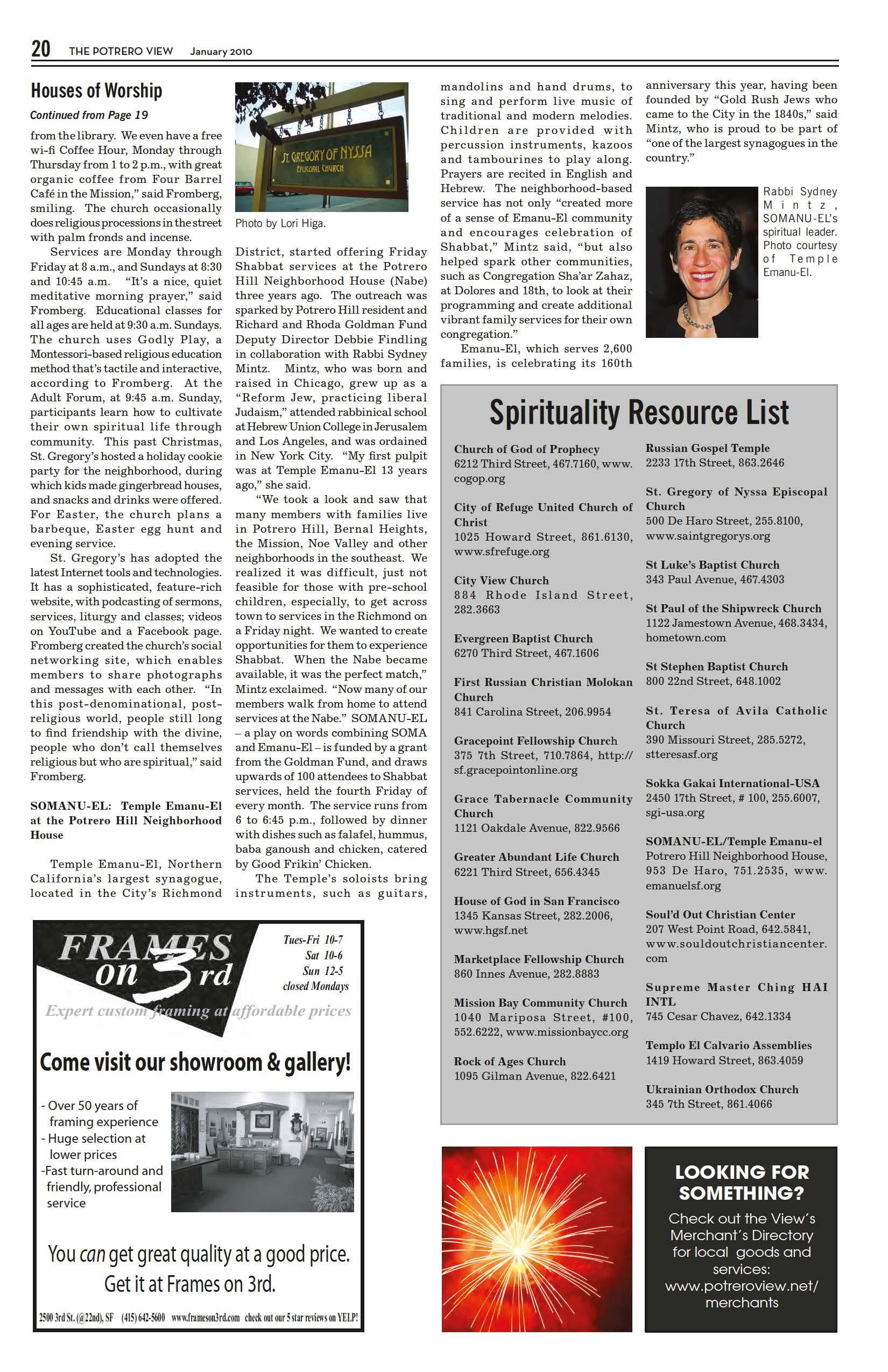

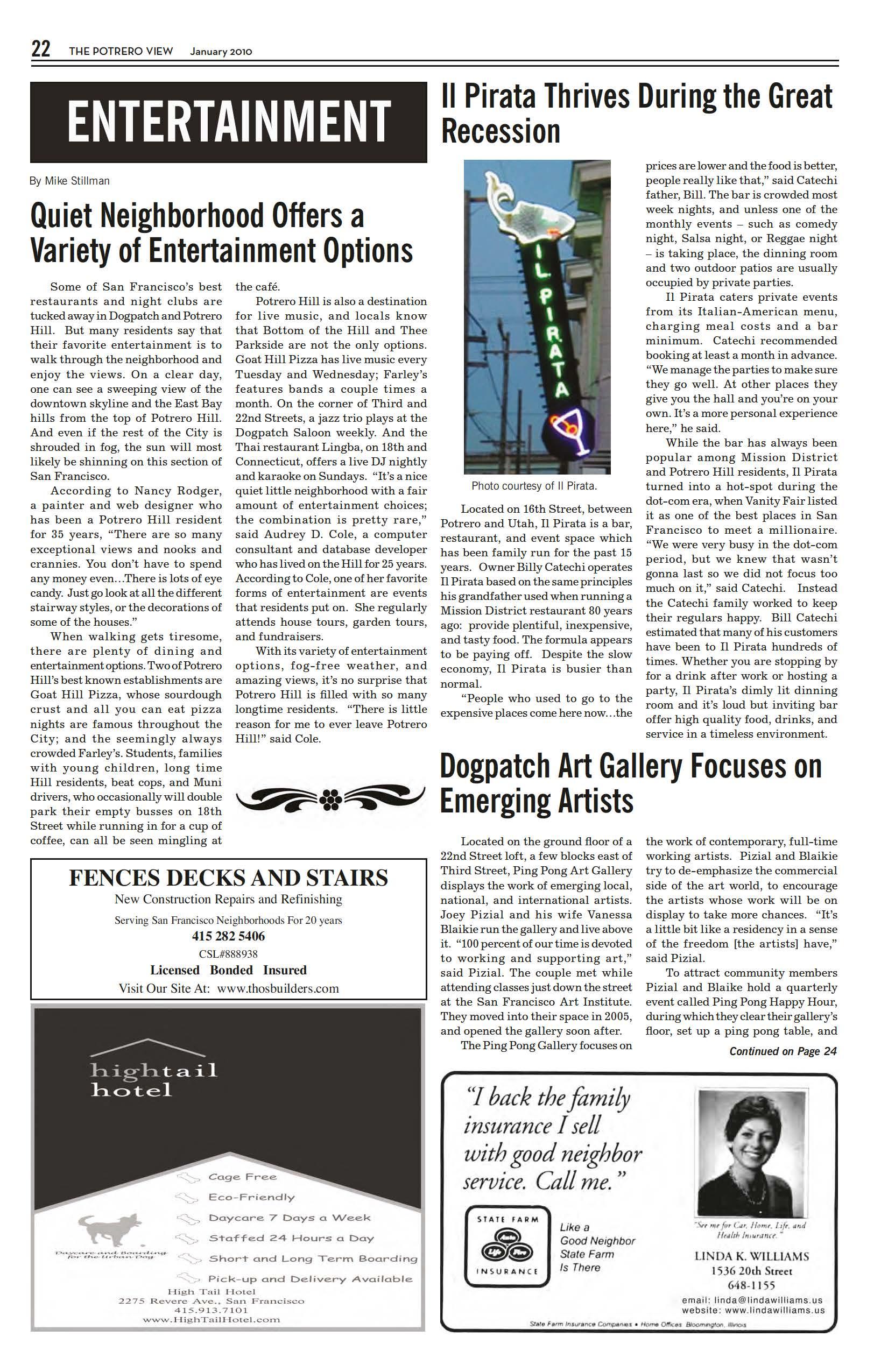

PingPong
ContinuedfromPage22 invite the public to have a few drinks and play a few rounds. According to Pizial, the event’s purpose is to turn the gallery into a social sculpture, becoming a piece of art in and of itself. With the Ping Pong Happy Hour, Pizial and Blaikie want to encourage the idea that gathering to socialize and talk about art is as important as looking at art.
Whether stopping by to play ping pong, or to view the work of up and coming artists, new comers are always welcome at the gallery. “Get to know your own back yard; there’s a lot of interesting things happening here,” said Pizial.
Last month California College of the Arts graduatedesignstudents installedHereNowThere
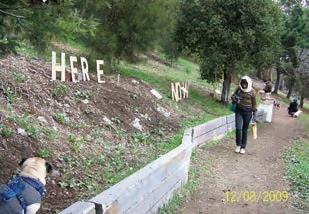

Then, a place-based art exhibit, at McKinley Square. Photo by DB Spahn.
SlovenianHall
ContinuedfromPage23 nothing,” said John, who asked that his last name not be used. Although they do little advertising, the Slovenian Hall has become a popular place for San Franciscans to throw parties. “We get pretty good ratings on those websites where you call in and make your own ratings,” John said, referring, presumably, to Yelp.

The building once served as the Western Power substation. Slovenian immigrants remodeled it into a gathering place. Some events, such as the blood sausage feed at the beginning of the year, still draw Slovenians from around the Bay Area.






